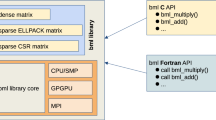Abstract
Orthogonalization with the prerequisite of kee** several vectors fixed is examined. Explicit formulae are derived both for orthogonal and biorthogonal vector sets. Calculation of the inverse or square root of the entire overlap matrix is eliminated, allowing computational time reduction. In this special situation, it is found sufficient to evaluate the functions of matrices of the dimension matching the number of fixed vectors. The (bi)orthogonal sets find direct application in extending multiconfigurational perturbation theory to deal with multiple reference vectors.

Similar content being viewed by others
Notes
Orthonormality of vectors \(\mathbf{c}^i\) is assumed since orthonormalizing m vectors is relatively cheap for \(m \ll N\).
References
Löwdin PO (1950) J Chem Phys 18:365
Löwdin PO (1970) Adv Quantum Chem 5:185
Mayer I (2002) Int J Quantum Chem 90(1):63. doi:10.1002/qua.981
Mayer I (2003) Simple theorems, proofs, and derivations in quantum chemistry. Kluwer, New York
Wolinski K, Sellers H, Pulay P (1987) Chem Phys Lett 140:225
Wolinski K, Pulay P (1989) J Chem Phys 90:3647
van Dam HJJ, van Lenthe JH (1998) Mol Phys 93:431
Werner HJ (1996) Mol Phys 89:645
Andersson K, Malmqvist PÅ, Roos BO, Sadlej AJ, Wolinski K (1990) J Phys Chem 94:5483
Andersson K, Malmqvist PÅ, Roos BO (1992) J Chem Phys 96:1218
Rolik Z, Szabados Á, Surján PR (2003) J Chem Phys 119:1922
Szabados Á, Rolik Z, Tóth G, Surján PR (2005) J Chem Phys 122:114104
Kobayashi M, Szabados Á, Nakai H, Surján PR (2010) J Chem Theory Comput 6:2024
Surján P, Rolik Z, Szabados Á, Kőhalmi D (2004) Ann Phys (Leipzig) 13:223
Mayer I (2000) Theor Chim Acta 104:163
Nagy P, Surján P, Szabados Á (2012) Theor Chem Acc (Theoretica Chimica Acta) 131:1109. doi:10.1007/s00214-012-1109-y
Limacher PA, Ayers PW, Johnson PA, De Baerdemacker S, Neck DV, Bultinck P (2014) Phys Chem Chem Phys 16:5061
Nagy PR, Szabados Á (2012) Int J Quantum Chem 113:230
Rayleigh LJWS (1976) The theory of sound, vol 1. Dover, New York
Schrödinger E (1926) Ann Phys 80:437
Lindgren I, Morrison J (1986) Atomic many-body theory. Springer, Berlin
Shavitt I, Bartlett RJ (2009) Many-body methods in chemistry and physics. Cambridge University Press, Cambridge
Hose G, Kaldor U (1979) J Phys B 12:3827
Meissner L, Bartlett RJ (1989) J Chem Phys 91:4800
Epstein P (1926) Phys Rev 28:695
Nesbet R (1955) Proc R Soc (Lond) A230:312
Surján PR (1999) Top Curr Chem 203:63
Surján PR, Szabados Á, Jeszenszki P, Zoboki T (2012) J Math Chem 50:534
Jeszenszki P, Nagy PR, Zoboki T, Szabados Á, Surján PR (2014) Int J Quantum Chem 114:1048
Rassolov VA, Xu F (2007) J Chem Phys 127:044104
Small DW, Head-Gordon M (2009) J Chem Phys 130:084103
Jeszenszki P, Rassolov V, Surján PR, Szabados Á (2015) Mol Phys 113(3–4):249
Johnson PA, Ayers PW, Limacher PA, Baerdemacker SD, Neck DV, Bultinck P (2013) Comput Theor Chem 1003:101
Acknowledgments
The authors are indebted to a Referee who helped to significantly improve the manuscript. The work presented here is a direct continuation of the research being followed in the laboratory of Péter Surján. It is a delight for the authors—all of them students of prof. Surján for some time in their life—to congratulate him on the occasion of reaching 60 and express their gratitude to the outstanding scholar.
Author information
Authors and Affiliations
Corresponding author
Additional information
Published as part of the special collection of articles “Festschrift in honour of P. R. Surjan.”
Rights and permissions
About this article
Cite this article
Tóth, Z., Nagy, P.R., Jeszenszki, P. et al. Novel orthogonalization and biorthogonalization algorithms. Theor Chem Acc 134, 100 (2015). https://doi.org/10.1007/s00214-015-1703-x
Received:
Accepted:
Published:
DOI: https://doi.org/10.1007/s00214-015-1703-x




